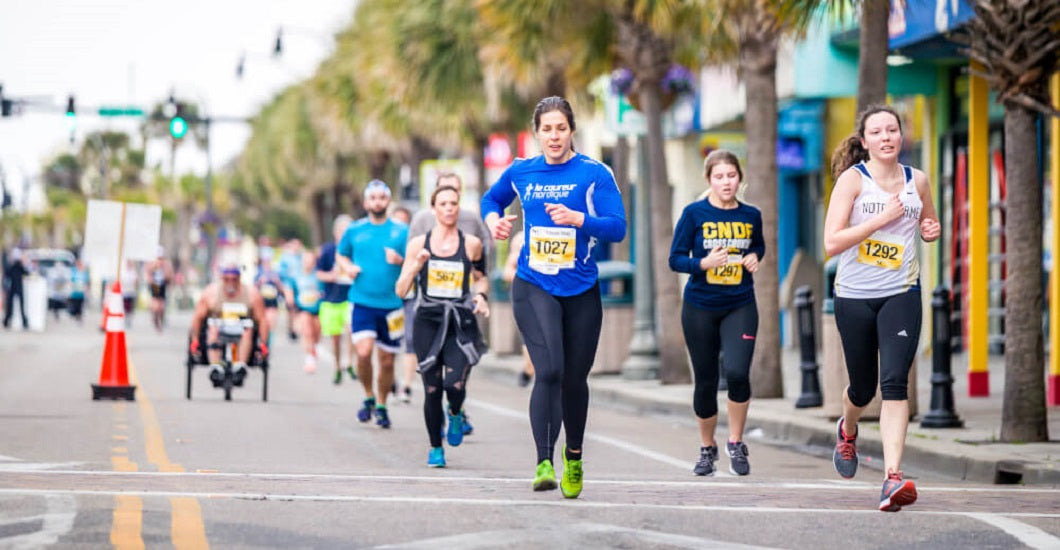The marathon is a sport that tests an athlete's physical strength and endurance. Whether you're a seasoned runner or a novice contemplating your first marathon, the question that inevitably arises is, How long does it take to run a marathon?
In this comprehensive guide, SupeRun takes an in-depth and multi-faceted look at the marathon. We will explore average marathon finishing times, factors affecting marathon finish time, and how to train for a marathon on a treadmill together.
What is a marathon?
A marathon is a long-distance running race. The name "marathon" has historical roots in ancient Greece and is inspired by the legendary run of a Greek messenger named Pheidippides from the town of Marathon to Athens to deliver a crucial message. The modern marathon race was established to commemorate this historical event and was first introduced in the 1896 Athens Olympics.

Marathons are typically held as road races, although some may take place on trails or other terrains.
Marathon runners often undergo rigorous training and preparation to build the stamina and endurance required to complete the race within a reasonable time.
How long is a marathon?
A marathon is a long-distance running race with an official standard distance of 42.195 kilometers, which is approximately 26.2 miles.
This standardized distance has been established by various governing bodies for the sport of athletics, including the International Association of Athletics Federations (IAAF), and is recognized as the official marathon distance worldwide.
How long does it take to run a marathon?
Average marathon finish times can vary widely depending on several factors, including the runner's experience, training, age, gender, and the specific marathon course.
Overview of Average Times:
The average marathon finish time for recreational runners typically falls in the range of 4 to 5 hours.
Elite runners and experienced athletes often complete marathons in much faster times, with some finishing in about 2 hours.
Breakdown by Gender:
Historically, men tend to have slightly faster average marathon finish times than women.
On average, male runners may finish a marathon in around 4 hours and 30 minutes, while female runners might finish in approximately 4 hours and 50 minutes.
Age Group Variations:
Marathon finish times can vary significantly among different age groups.
Younger runners (e.g., 20s and 30s) often achieve faster times, while older runners (e.g., 50s and 60s) may have slower average finish times.
Average Marathon Times(hours): Male
|
Age Group |
Beginner |
Novice |
Intermediate |
Advanced |
Elite |
|
20-30 |
4.95 |
4.17 |
3.57 |
3.13 |
2.82 |
|
31-40 |
5.00 |
4.22 |
3.62 |
3.18 |
2.85 |
|
41-50 |
5.32 |
4.47 |
3.85 |
3.53 |
3.02 |
|
51-60 |
5.80 |
4.88 |
4.20 |
3.68 |
3.30 |
|
61-70 |
4.38 |
5.38 |
4.62 |
4.05 |
3.63 |
|
71-80 |
7.27 |
6.12 |
5.25 |
4.62 |
4.13 |
|
81-90 |
9.40 |
7.92 |
6.80 |
5.97 |
5.35 |
Average Marathon Times(hours): Female
|
Age Group |
Beginner |
Novice |
Intermediate |
Advanced |
Elite |
|
20-30 |
5.55 |
4.75 |
4.13 |
3.67 |
3.32 |
|
31-40 |
5.58 |
4.78 |
4.17 |
3.70 |
3.33 |
|
41-50 |
5.93 |
5.08 |
4.43 |
3.92 |
3.55 |
|
51-60 |
6.67 |
5.72 |
4.98 |
4.42 |
3.98 |
|
61-70 |
7.70 |
6.60 |
5.75 |
5.10 |
4.60 |
|
71-80 |
9.20 |
7.88 |
6.87 |
6.08 |
5.50 |
|
81-90 |
12.88 |
11.05 |
9.62 |
8.53 |
7.70 |
Historical Trends:
Historical data shows that average marathon finish times have been gradually increasing over the years.
This trend can be attributed to the growing popularity of marathons, attracting a wider range of participants.

However, elite marathon times have continued to improve, with world records being broken periodically.
Factors Affecting Marathon Finish Time
The finish time of a marathon is influenced by a variety of factors, both individual and external. Here's an overview of the key factors affecting marathon finish time:
Physical Fitness Level:
The runner's overall physical fitness and conditioning significantly impact marathon performance.
Higher fitness levels often result in faster finish times, as well-conditioned muscles and cardiovascular systems can sustain a faster pace over the marathon distance.
Regular exercise and proper nutrition are essential for building and maintaining fitness.
Training Intensity and Duration:
The intensity and duration of a runner's training regimen are critical factors.
Consistent, structured training programs that include long runs, speed workouts, and recovery sessions help improve endurance and speed.
The more dedicated and focused the training, the better the chances of achieving a faster finish time.
Terrain and Course Difficulty:
The specific marathon course and its terrain can significantly affect finish times.
Courses with flat, smooth roads are generally faster than those with hilly or rugged terrain.
Trail marathons, for example, tend to be slower than road marathons due to the technical nature of the terrain.
Weather Conditions:
Weather conditions on race-day can have a substantial impact on marathon performance.
Ideal conditions include moderate temperatures, low humidity, and minimal wind.
Extreme weather conditions such as heat, cold, rain, or strong winds can slow down runners and affect their times.
How to train for a marathon on a treadmill?
Training for a marathon on a treadmill can be an effective way to build your endurance and prepare for the race. If you have limited access to outdoor running routes or prefer the controlled environment of a treadmill, training on a treadmill is a good choice. Here's a step-by-step guide on how to train for a marathon on a treadmill:
Consult with a Physician:
Before starting any marathon training program, consult with a doctor to ensure you are physically fit for such an intense endeavor.
Set Clear Goals:
Define your marathon goals, including your target finish time and race date. Having clear objectives will help you plan your training program effectively.
Create a Training Plan:
Develop a customized marathon training plan that includes a mix of endurance runs, speed work, and recovery days. There are many marathon training programs available online that can be adapted for treadmill use.
Invest in Quality Equipment:
Use a reliable and well-maintained treadmill to ensure safety and accuracy during your training.
Make sure your treadmill is equipped with safety features like an emergency stop button and a safety key. The SupeRun treadmill is an ideal choice for everyone.
Choose the Right Treadmill Settings:
Start with a comfortable pace and gradually increase the speed and duration as you progress in your training.
Incorporate Variety:
Vary your treadmill workouts to mimic outdoor conditions. Include long slow runs, tempo runs, and interval training.
Adjust the speed settings to match your training plan's requirements.
Stay Hydrated and Fuel Properly:
Even though you're indoors, it's essential to stay hydrated and maintain proper nutrition during your treadmill runs, especially on longer training days.
Focus on Mental Toughness:
Treadmill running can be mentally challenging due to the lack of scenery. Practice mental toughness and distraction techniques like listening to music, podcasts, or audiobooks.
Simulate Race Conditions:
On occasion, simulate race day conditions by running at your goal marathon pace and practicing your race-day nutrition and hydration strategies.
As a smart treadmill, the SupeRun treadmill can link to PitPat. People can follow professional running courses and running competitions online.

Monitor Progress:
Keep a training log to track your mileage, pace, and how you feel during each workout.
Use fitness tracking or fitness apps or wearable devices to monitor your heart rate, distance, and other relevant data. SupeRun treadmills can link to a fitness app - PitPat, which can help people track body conditions and data.
Cross-Training and Strength Training:
Incorporate cross-training activities like cycling or swimming to prevent overuse injuries.
Include strength training exercises to improve overall muscular strength and stability.
Rest and Recovery:
Ensure you get enough rest and recovery days in your training schedule to prevent overtraining and reduce the risk of injury.
Gradually Increase Mileage:
Build up your weekly mileage gradually to avoid overexertion and minimize the risk of injury.
Taper Before the Race:
In the final weeks leading up to the marathon, reduce your training volume (taper) to allow your body to recover and be fresh for the race.
Test Outdoor Runs:
As the race date approaches, incorporate some outdoor runs to adapt to the differences in terrain and conditions.
Remember that training for a marathon on a treadmill can be effective, but it's also essential to mentally prepare for the challenges of running a long-distance race indoors. Stay motivated, stay consistent, and always prioritize safety and injury prevention throughout your training journey.
Conclusion
We've explored the myriad factors that influence marathon finish times, from physical fitness and training intensity to the nuances of terrain and the unpredictability of weather conditions.
The marathon is not solely measured in minutes and seconds. It's about the dedication to training, the camaraderie of fellow runners, and the moments of triumph and adversity that shape your experience.
So, lace up your running shoes, set your goals, and hit the pavement or treadmill with determination. Whether you aim to break records or simply savor the joy of finishing, enjoy running!






Leave a comment
All comments are moderated before being published.
This site is protected by hCaptcha and the hCaptcha Privacy Policy and Terms of Service apply.